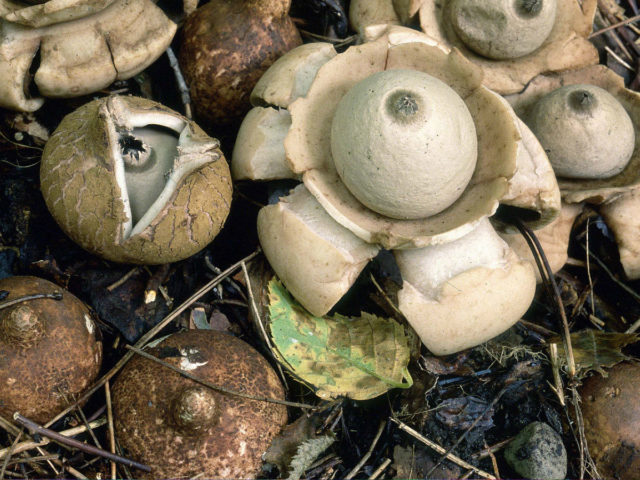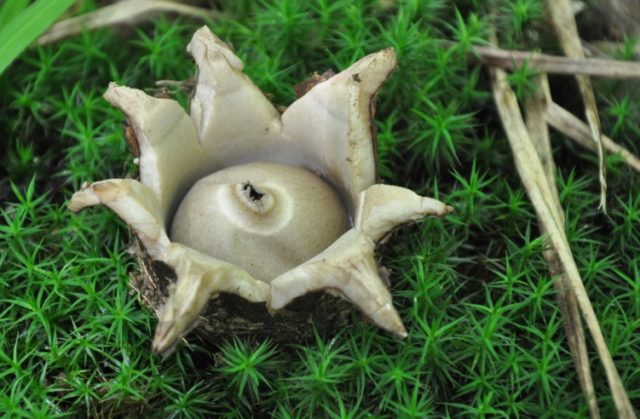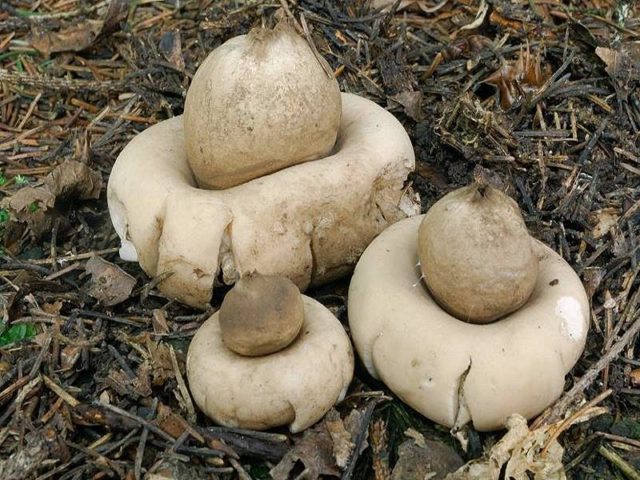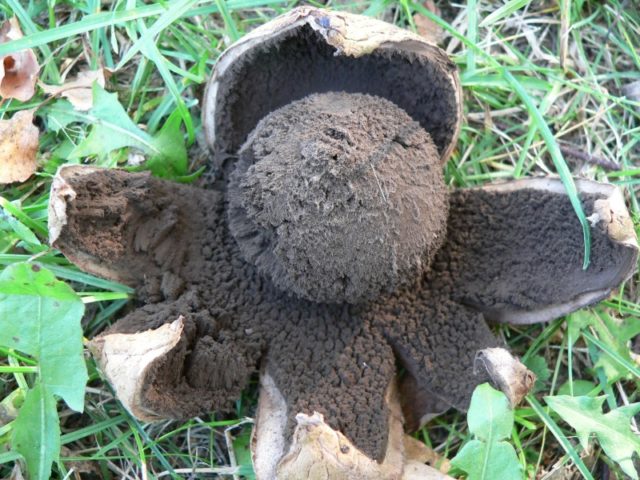Content
Geastrum triple belongs to the Zvezdovikov family, which got its name due to its characteristic appearance. The fruit body of this mushroom has a unique shape, which makes it difficult to confuse it with other representatives of the forest kingdom. Distributed almost everywhere.
What a triple geastrum looks like
The fruit body of the triple geastrum has a round shape. There is a slight bulge in the center of its upper part. The height of the fruiting body of the triple geastrum reaches 5 cm, and the diameter rarely exceeds 3.5 cm. Young mushrooms look like champignons or raincoats with a tubercle.

The appearance of fruiting bodies at different stages of maturity
With age, the outer layer breaks into 3-7 lobed-shaped parts. The diameter of the unfolded shell of the fruiting body can reach 12 cm. Externally, the triple geastrum becomes like a star. The color of the mushroom can be very diverse - from light brown to white or dark gray.

"Opened" geastrum triple
The flesh of the inside is loose and soft. But the outer cracking shell has a denser structure - it is elastic and leathery.
The spores mature in the interior of the fungus. In the place of formation of the tubercle, over time, a hole appears through which they are sown.
Where and how it grows
It is found throughout the planet in temperate and, in some cases, subtropical climates. It adapts well to temperature fluctuations.
It lives in mixed or deciduous forests, yet prefers to form mycorrhiza with conifers. It is often found in places of accumulation of discarded leaves and spruce branches. It is undemanding to soils. It is found mainly in large groups of several dozen mushrooms in one place.
Fruiting occurs in late summer and September. At the slightest touch, the spore sac bursts and covers everything around with gray powder.
Is the mushroom edible or not
Geastrum triple is not poisonous, but it is not eaten either, since the inner pulp is loose and tasteless. The outer shell, in addition to being inedible, is still too hard and leathery. Refers to the inedible group.
Doubles and their differences
Given the characteristic appearance of the triple geastrum, it is very problematic to confuse it with representatives of any other families. On the other hand, among his "relatives" related to the Zvezdovikovs, there are many doubles who may be mistaken for him. These varieties are discussed in more detail below:
Fringed starfish
Unlike geastrum, triple has a darker shade. In addition, the outer shell, after rupture, is tucked almost to the stem. Just like the triple geastrum, it is not edible.

In a fringed starfish, the outer shell curls with greater intensity.
Geastrum blackhead
It is distinguished by its larger size (up to 7 cm in height), a strongly protruding tubercle and a characteristic color when opened.In addition, this twin is found exclusively in deciduous forests.

Sowing of spores of this species occurs already at the stage of opening the leathery membrane
Starfire crowned
Differences in appearance are manifested in the structure of the inner part of the fruiting body: it is more flattened. The spores are brown and the stem is practically absent. In addition, this variety is found mainly on clay soils.

The crowned starfish has a smaller size and a flattened shape of the inner fruiting body.
Like the triple geastrum, it is classified as inedible. It is a rather rare species with a limited habitat - it is found only in the European Plain and in the North Caucasus.
Conclusion
The Zvezdovikov family, to which the triple geastrum belongs, has a unique appearance, so it is unlikely to confuse this mushroom with any other. A feature of this species is its good adaptation to the environment and ubiquity. All members of the family belong to inedible mushrooms, since their pulp is not only loose, but also tasteless.








